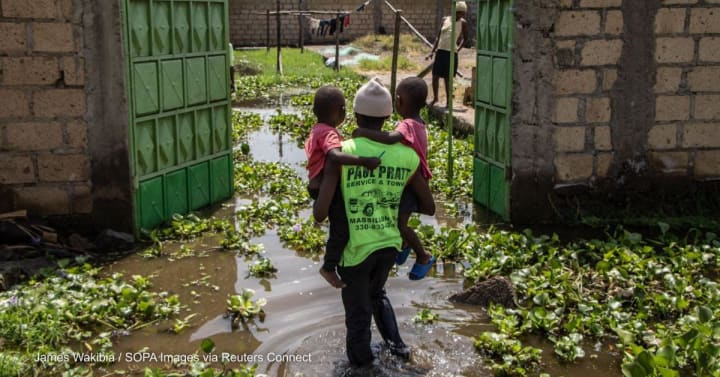
East African health systems are facing tough times as the region continues to take hits from extreme weather, amid a development space struggling to compete for funds with other crisis-troubled parts of the world.
The recent floods in East Africa fuelled water-borne diseases such as cholera with vector-borne diseases like malaria, dengue fever, and chikungunya on the rise, said Dr. Martin Muchangi, the director for population health and environment at the African Medical and Research Foundation, or AMREF.
“A disease like cholera is so easy to manage in situations where you have sanitary provisions. But now what we see is in situations where communities had access to safe water and sanitation, floods have taken them away. Mosquitoes are now breeding for a longer time than expected where there were floods,” he said in an interview with Devex.
While health experts warn of new disease outbreaks due to climate shocks, local NGOs say the lack of emergency response budgets is crippling their ability to battle disasters.
That means a lot of trouble for the health sector in the East African region, which Muchangi said has very low investment due to a lack of donor support and budget cuts by governments. Recently, civil unrest erupted in Kenya due to unpopular financial policies that included slashing the health budget by about 14 billion Kenyan shillings (about $110 million).
Climate change and other global shocks have made the health infrastructure more vulnerable, medical supply chains are muddled by corruption, while technological advances and information that can help the health sector plan and prepare for emergencies are not accessible, Muchangi said.
“The resilience of the health sector in the East Africa region is really troubled. Just the other day when health facilities were submerged underwater, communities could not access them and mothers could not go and deliver in those hospitals,” Muchangi added.
During this year’s rainy season, torrential rains unleashed severe flooding and mudslides, and damaged vital infrastructure such as roads, bridges, and dams, displacing hundreds of thousands in Kenya, Tanzania, Rwanda, Burundi, Ethiopia, and Somalia.
Weather forecasters say the heavy rains may be over, but the region is still in a disaster cycle and it could take over two years for affected communities to recover from the floods, Michael Thiauri, the emergency coordinator at the International Rescue Committee Kenya, or IRC Kenya, said.
Children from families that are still in camps are yet to report to school, while hospitals are reporting increased admissions due to disease outbreaks. Traumatized families are struggling to get back to their normal lives as inflation on food items continues to trouble the region, he said.
“Some regions that are still flooded are at risk of malnutrition for children under 5 years of age because of lack of food and medical services,” Thiauri said.
Though the post-floods grim outlook has united civil society, governments, and humanitarian agencies to respond to the fallout, grassroots organizations in the region, which are the immediate responders to crises, are lacking resources, Pauline Madiro, the regional coordinator of East and Southern Africa at the Global Network of Civil Society Organisations for Disaster Reduction, or GNDR, said.
Their limited resources during the emergency overwhelmed response teams and the funding made available for emergency response has been depleted, she added.
While civil society groups do not have as much funding as humanitarian agencies and governments, the funding that comes through is restricted to specific interventions and not necessarily for emergencies, Madiro said.
There are several reasons why civil society groups lack flexibility in allocating funds for emergency responses, with Madiro pointing out that some donors lack confidence in giving direct funding to local organizations, claiming they do not have stable structures and sufficient capacity.
With such an outlook, donors have been allocating funds to local organizations through intermediaries. A lot of this money gets lost in administration costs before it reaches the recipients, she said.
“Funding plays a very integral part in implementation but it has not been very sustainable to our local NGOs,” Madiro said. “When it comes to emergencies it is a bit difficult to get that unrestricted funding to respond to a certain emergency. If the money is restricted to for example climate adaptation, you can’t pick this and say it is going to climate mitigation. You must have a valid reason for it.”
GNDR is helping local organizations navigate these challenges by advocating for international donors to realize and appreciate the capacity within the civil society space.
The civil society network also gives local organizations in the region visibility to win contracts with international partners, while also helping them with capacity building and fostering collaboration with peer organizations locally and regionally, she said.
But, with the cessation of the floods attention by donors and governments has gone down, affecting fundraising efforts to manage the fallout from the crisis, Thiauri said.
As the lead agency in terms of disaster response in the region, Kenya Red Cross, or KRC, officials said 2,458 water facilities were destroyed by the floods, while 189 camps are still sheltering displaced families.
“We still have the capacity to respond to the flooding fallout. Agencies are trying their best but resources are never enough,” said Anthony Muchiri, the emergency response manager at KRC.